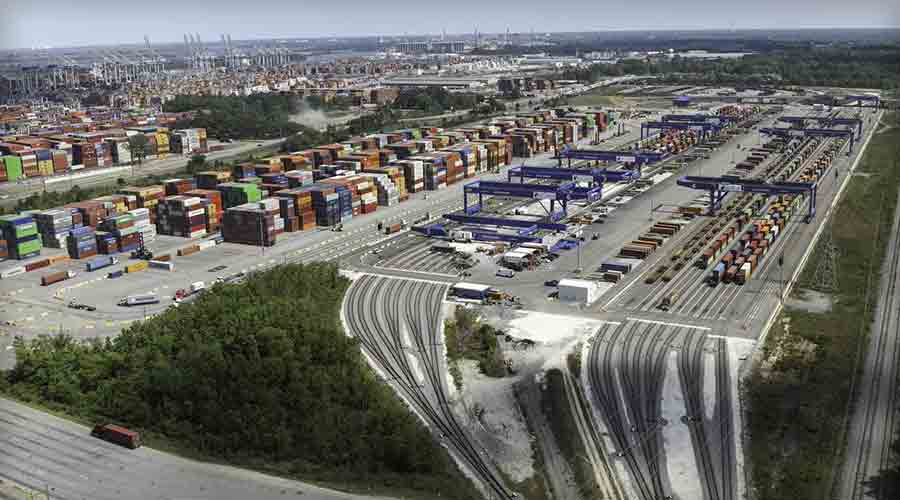Georgia Ports Authority's mission: Expand, expand, expand
7/11/2022
By Grace Renderman, Associate Editor
As shippers navigate a range of supply-chain challenges and seek alternative freight routes, the Georgia Ports Authority (GPA) is ramping up capacity to meet their near- and longer-term needs.
The GPA — which governs the Port of Savannah, the Port of Brunswick and a handful of inland transload operations — is in the midst of completing a series of projects designed to turn Savannah’s Garden City Terminal, a 6-million 20-foot equivalent unit (TEU) facility, into one capable of processing up to 7 million TEUs annually. GCT is the nation’s largest single-operator terminal.
Comprising GCT and Ocean Terminal, which is dedicated to roll-on/roll-off and breakbulk cargo, the Port of Savannah reached an all-time monthly high in May at 2.44 million TEUs, with a projected total 5.8 million TEUs to be handled by year’s end.
As part of the recently completed Savannah Harbor Expansion Project, the waters were deepened from 42 feet to 47 feet, enabling the port to receive heavier ships carrying more cargo, says Duke Acors, GPA’s director of strategic operations. An advantage of having a deeper berth: Shippers don’t have to wait for the tide to come in because they’ve already got enough depth to handle the extra cargo, giving them more flexibility.
The port’s rail capacity will increase by 30% by year’s end, too, through the Mason Mega Rail Terminal project. The project includes the addition of an 85-acre rail yard with an on-dock rail facility, which port leadership claims is the largest of its kind in North America; it’ll also provide the capacity for six 10,000-foot trains, Acors says. Three tracks are complete, and an additional three will be finished by the end of the year.
"We feel it’s a strategic advantage and a competitive advantage for GPA,” Acors says.
The authority also is about halfway through renovating Container Berth 1 at Garden City Terminal, which will increase the berth’s annual capacity by 1.4 million TEUs. A $34.6 million federal grant is helping to fund the project.
Plans for a new inland container port along the Interstate 85 corridor should also help with freeing up space. To be built at the Gateway Industrial Centre in Gainesville, the port will be served by NS, connecting directly to Savannah via Atlanta, Acors says. The U.S. Department of Transportation’s Nationally Significant Multimodal Freight & Highway Project program last month awarded a $46.8 million grant to GPA to build the port, which will operate on 104 acres with a capacity of 200,000 container lifts per year.
A Hyundai electric vehicle and battery manufacturing plant planned in nearby Bryan County will also likely raise the port’s volumes, Acors says. The plant is scheduled to open by 2025.
Wanted: New business opportunities
Meanwhile, GPA is seeking out new business opportunities. Chicago is one market that’s currently “underserved” by the Port of Savannah, Acors says. Shippers are looking for ways to move their coast to coast in a timely manner, and as a result, some are looking to break into Midwestern markets. The port gives them an option to do just that while steering clear of congested West Coast ports on the West Coast, he says.
“We're very competitive on timing compared to other ports that are competing [against] us, especially on the West Coast,” Acors says. “[Considering] the high-volume move on vessels, combined with a shorter overland route from East Coast ports, we think it makes a lot of sense to move that cargo through the Port of Savannah.”
Despite rail throughput being “off” due to declining intermodal volumes during the year’s first half, GPA has worked to keep up port-to-port moves via rail, Acors says. The authority has worked with third-party logistics providers over the last six months who specialize in moving empties and taking them further inland via rail.
“Typically, these containers move naturally into inland markets,” Acors says. “Now today, knowing that we are seeing more containers potentially being transloaded into Savannah and moved there to keep the empties closer, we want to give customers the opportunity to ... move their container ... to a market inland.”
In transporting the empties, GPA officials discovered that “pop-up” rail yards are popular with rail partners — including CSX and Norfolk Southern Railway, both of which serve the port. Those yards process dwelling containers and move them closer to where they are needed, freeing up terminal space and relieving congestion to ease cargo flow, Acors says.
“Infrastructure improvements and pop-up yards … have enabled our operations to maintain the flow of cargo across our terminal, despite the unprecedented container volumes,” Acors says. “Capacity expansion at the Port of Savannah will allow GPA to continue providing the fast and reliable movement of cargo that customers have really come to expect.”

